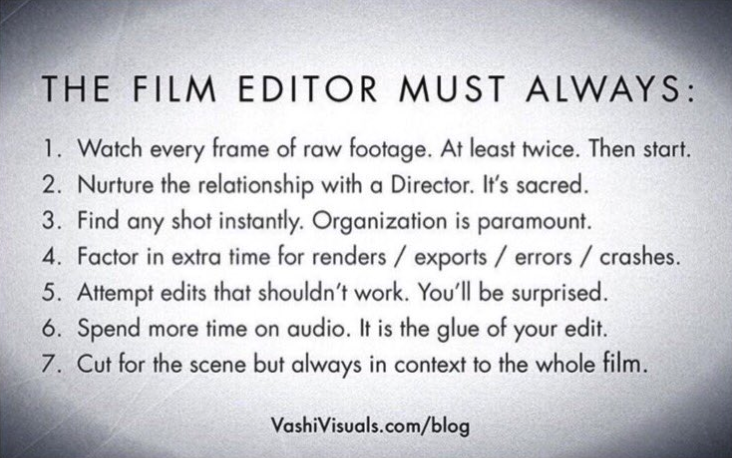In this Video Vashi Nedomansky talks about his 7 laws of editing.
1. Watch every frame of raw footage. At least twice. Then start. Ask any pro editor and they’ll tell you: Watching all the dailies is crucial. Start to finish. From the first to the last frame. The best reaction of an actor might come after the director has called “cut” because they relax and stop performing. Vashi suggests watching your footage twice: once from start to finish, letting the footage wash over you. Then again to take notes.
2. Nurture your relationship with the director The editor is the only other person who gets to see all the weaknesses and flaws of the film. The editor is also the one that needs to fix them. So, that relationship with the director is very special. It’s like a marriage that needs to endure all the challenges of rearing the film. If you have an ego or are short-tempered, no talent will keep you from getting fired. Be open minded, be nurturing, and most importantly, listen more than you speak.
3. Find any shot instantly. Organization is paramount. I actually think this goes hand in hand with number one. As you are watching and taking notes, it’s very important to sort the footage in the right place. A good folder and coding system helps you remember how you felt and gives you instant access to your instincts.
Video
4. Factor in extra time for renders, exports, errors, and crashes Pro editors deliver on time all the time. To follow through on that part of your brand (which is simply a promise of an experience), you must have a plan in place for mishaps and always check your work before it leaves your hands.
5. Attempt edits that shouldn’t work. You’ll be surprised. Some of my best edits come from happy accidents. You never know how two shots will work together unless you throw them in a timeline and watch what they do.
6. Spend more time on audio. It’s the glue of the edit. I bet you’ve heard this one before. But it is astounding to me how many cuts I watch with little care for audio with the excuse that this will be fixed later by the sound.
7. Cut for the scene but always in context to the whole film. Scenes have an arc on their own, but they really ultimately need to work in context with what happens overall. So, cut each scene as good as it can be, but then play them as connected beats and see how they hold up. Do they need to be shorter or longer? Do they need a different focus?
Read Full article on https://wipster.io/blog/seven-commandments-film-editing












